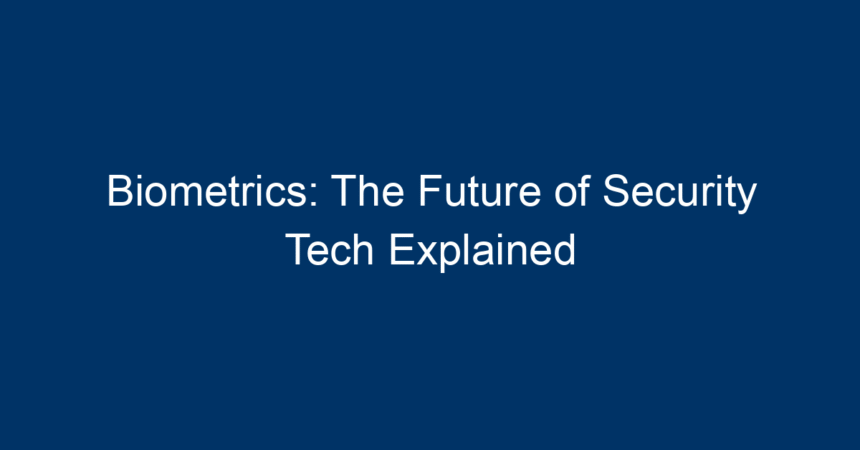In a rapidly evolving technological landscape, security is paramount. As traditional security measures become increasingly vulnerable, the need for advanced solutions has never been more critical. Enter biometrics—a revolutionary approach to security that leverages unique physical or behavioral characteristics for identification and authentication. From fingerprint scanners to facial recognition, biometrics is transforming how we secure personal information and spaces. In this article, we’ll delve into what biometrics is, its applications, advantages, and potential challenges, providing a comprehensive understanding of why it represents the future of security technology.
What Is Biometrics?
Biometrics involves using physiological or behavioral traits to authenticate an individual’s identity. Unlike passwords or PINs, which can be forgotten or stolen, biometric data is unique to each individual. Common types of biometric identifiers include:
- Fingerprint Recognition: The most widely used form, where patterns on a person’s fingertip are scanned and matched.
- Facial Recognition: Analyzes facial features and structures to authenticate identities.
- Iris Recognition: Utilizes the unique patterns in the iris to verify identity.
- Voice Recognition: Evaluates vocal characteristics and patterns for identification.
- Behavioral Biometrics: Includes patterns in typing speed, walking gait, or even usage patterns on devices.
As society becomes increasingly digitized, the adoption of biometrics is not just promising—it is essential.
The Growing Importance of Biometrics in Security
Enhanced Security
One of the primary advantages of biometrics is the heightened level of security it offers. Unlike traditional passwords, which can be compromised through hacking, social engineering, or phishing, biometrics are significantly more challenging to replicate. This high level of security is crucial in various sectors, including banking, healthcare, and government.
Convenience and Efficiency
Biometric systems simplify the authentication process. Users no longer need to remember complex passwords or carry multiple ID cards. With a simple touch of a finger or a glance, access is granted swiftly and seamlessly. This convenience not only improves user satisfaction but also increases operational efficiency in businesses.
Fraud Prevention
In industries susceptible to fraud, such as finance and retail, biometrics serve as a robust deterrent. By implementing biometric authentication systems, organizations can minimize the risk of identity theft and fraudulent activities. For example, using facial recognition technology at bank ATMs can prevent unauthorized access to accounts, thus protecting both the user and the institution.
Applications of Biometrics
The applications of biometrics are vast and varied. Here are some of the most impactful areas where this technology is making a difference:
1. Banking and Financial Services
Banks are increasingly adopting biometric authentication methods to secure transactions. Fingerprint scanners and facial recognition systems enable customers to access their accounts or authorize payments without the need for passwords. This shift not only enhances security but also streamlines the customer experience.
2. Healthcare
In the healthcare sector, ensuring the privacy and security of patient data is of utmost importance. Biometrics can safeguard sensitive information, allowing healthcare providers to verify identities quickly and accurately. This technology reduces the risk of medical fraud and improves patient care by ensuring that only authorized personnel have access to medical records.
3. Travel and Immigration
Airports and border control agencies are increasingly leveraging biometric systems for identity verification. Facial recognition technology expedites the check-in process at airports, while biometric passports—equipped with embedded biometric data—facilitate quicker and more secure border crossings.
4. Smart Devices
With the rise of smart technology, biometrics is becoming integral to personal devices like smartphones and laptops. Features such as fingerprint recognition and facial recognition not only enhance security but also provide a seamless user experience, making technology interaction more intuitive.
5. Law Enforcement
Biometrics is a powerful tool for law enforcement agencies. Facial recognition software and fingerprint analysis assist in solving crimes and identifying suspects. By maintaining biometric databases, law enforcement can quickly match suspects with existing records, thus enhancing public safety.
Advantages of Biometrics
The benefits of biometrics are multifaceted. Here are some key advantages that make this technology so appealing:
Security
Biometrics offers a more secure solution compared to traditional authentication methods. Since biometric traits are unique and difficult to replicate, they provide a high level of assurance, reducing vulnerabilities in security systems.
User-Friendly
The convenience associated with biometrics cannot be overstated. Users can authenticate their identities quickly and easily without the burden of remembering passwords. This user-friendly experience is one of the main drivers behind the technology’s rapid adoption.
Cost-Effective
For organizations, the initial investment in biometric systems can lead to significant long-term savings. By reducing fraud, streamlining processes, and improving security, companies can offset the costs associated with implementing these technologies.
Challenges and Concerns
Despite its numerous advantages, the adoption of biometrics does come with challenges:
Privacy Issues
As biometric data is inherently personal, its collection and storage raise significant privacy concerns. Users must trust companies and institutions to handle their biometric information responsibly. Data breaches involving biometric data can lead to severe consequences, as this information cannot be changed like a password.
Implementation Costs
While biometric systems can be cost-effective in the long run, the initial setup can be expensive. Organizations must invest in specialized hardware and software, as well as train staff to manage and operate these systems effectively.
Technical Limitations
Not all biometric systems are foolproof. Factors such as lighting conditions, environmental factors, and the physical condition of the user can impact the effectiveness of biometric authentication. Continuous advancements in technology are required to address these limitations.
The Future of Biometrics
The trajectory of biometrics indicates that it will play an increasingly significant role in security technology. Innovations in artificial intelligence and machine learning are set to enhance the capabilities of biometric systems, making them smarter and more secure.
Additionally, as public awareness grows regarding the potential of biometrics, more industries are likely to adopt this technology. The demand for secure, efficient authentication methods will continue to drive developments, paving the way for even more advanced biometric solutions.
Conclusion
Biometrics represents a fundamental shift in how we approach security technology. By leveraging unique physical and behavioral characteristics, biometrics offers enhanced security, convenience, and efficiency across various sectors. However, with the benefits come challenges, including privacy concerns and implementation costs.
As the future unfolds, organizations that invest in biometric solutions will likely remain ahead of the curve, providing more secure environments for users. Embracing this technology today will pave the way for a more secure digital landscape tomorrow.
Actionable Insights
- Stay Informed: Keep up with advancements in biometric technology to understand its benefits and challenges.
- Evaluate Your Needs: Assess your organization’s security requirements and consider implementing biometric solutions that align with your goals.
- Prioritize Privacy: When adopting biometric systems, ensure that data protection measures are in place to safeguard user information.
- Invest Wisely: Consider the long-term benefits of biometrics to justify the initial setup costs.
By recognizing the potential of biometrics and integrating it into security strategies, individuals and organizations can enhance their security posture while fostering a more secure environment for all.




